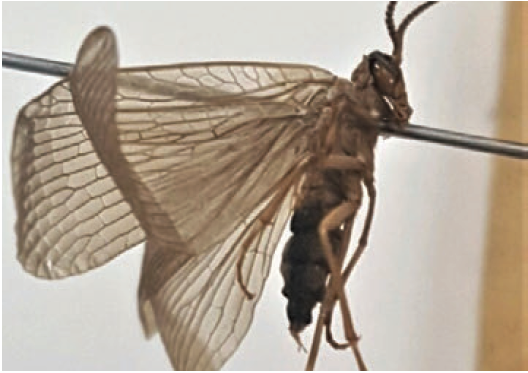Glené Mynhardt, Ph.D., Associate Professor of Biology and Associate Dean, Hanover College, and her student interns set out to determine insect diversity in the Combs Creek Ecoblitz area of Hoosier National Forest in summer 2019. Their work included setting up eight Malaise traps within various micro-habitats to collect and document what six-legged invertebrates live there. Malaise traps resemble large tent-like structures that intercept insects as they fly into a panel–the insects are drawn toward the sun and fall into a collecting jar filled with preservatives. Throughout the summer, Mynhardt and some of her students regularly collected the insect-filled jars to take back to the labs at Hanover College. Then the real work began.
The insects are sorted by morphotype, pinned, then identified. While the students are only now beginning to sort through samples months later, they have made a discovery that most entomologists have never seen: a forcepfly (Merope tuber), also known as an earwigfly!
These mysterious insects are so named because of the male fly’s pincer-like terminal appendages, which are likely used in mating. Forcepflies were first discovered in 1837 and still tend to be rare in collections. Before 1954, these insects were only collected in areas east of the Appalachian Mountains but have since been documented in various states, including localities in Indiana and farther west, most likely due to increased sampling efforts.
Biologists consider forcepflies to be a biological mystery. All they know is that these insects tend to be found in deciduous forests near water and that they are nocturnal. Yet no confirmation about their feeding habits exists nor have their larvae ever been documented. While Dr. Mynhardt was not surprised that M. tuber lives in Indiana’s forests, she was thrilled that her team found a handful of females. Because of this discovery, she and her students will try to find forcepfly males and larvae in future surveys at Combs Creek. This discovery underscores the importance of IFA’s Ecoblitz efforts to document and understand better the biodiversity that exists right here in Indiana.
Interested in Reading More?
This article first appeared in the Forest Defender, a journal published by the Indiana Forest Alliance. Receive your print copy of the Forest Defender when you join IFA.

